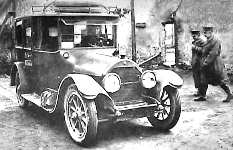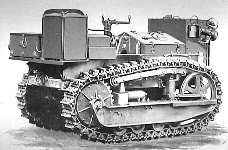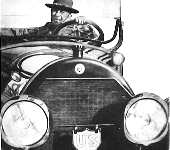|
[ last update: 03.03.2003 ] Best viewed with a screen image size of 600 x 800 pixels
The (new)
Cadillac Database©
Photo Pages
Cadillac
Participation in WW1
Return to The
(New) Cadillac Database© Index
Page
or go back to the Cadillac photo index page to pick another
year
or go to the La Salle photo index page
|
Among the curios in my collection is a book entitled Cadillac Participation in the World War. Published in 1919 by the Cadillac Motor car Company, it is illustrated with photos from European battle fronts as well as with others of war-related activities going on at home.
The frontispiece states that the book is an expression of appreciation to Cadillac men for their loyal service in a great emergency. It is also a historical account of Cadillac accomplishments in that great war. The book is dedicated to the men of the Cadillac Motor Car Company by its then CEO, Herbert Rice Collins, in recognition of their patriotic efforts in these most difficulty times. Cadillac stated that it was glad to have been able to contribute something to the strength of the nation and its allies; it was proud if that contribution was even a step toward victory.
Just as France's taxicab army had helped to stay the German onslaught on the Marne, thousands of Cadillac cars served daily on the various European fronts; they were the preferred transportation of allied staff, carrying officers quickly from one battle spot to another.
|
On the occasion of large offensives, such as those of Chateau Thierry and St.Mihiel, large numbers of these cars were permanently on call. Their gas tanks were kept full to the brim and each car had a spare tank strapped to the RH running board (photo). Travelling shell-damaged roads had quickly demonstrated the superior qualities of the Cadillac. Some of these cars were used also to relieve the French railroads of some mail runs; the mail cars would cover 150 to 200 miles a day at speeds up to 50 mph. Ten of these cars were sold to the French Government for use by French generals.
The choice of the Cadillac as the standard army car was founded on past experience. It had demonstrated already its sturdiness and dependability on the Mexican border. The English and Canadian governments had used a large number of Cadillac chassis for their ambulances on the front. In addition there had been a severe, competitive test at Marfa, TX, in July 1917.
Located on the Texas-Mexico border, Marfa was the scene of a 2000-mile endurance run, after which the test Cadillac completed an additional run of 5000 miles in equally tough conditions. Automobile men conceded that this was equal to 20,000 miles of average driving.
Apart from its olive drab finish, the optional tire chains and the spare gas can, the army car was the same as the regular cars seen on American roads at the time.
A total of 2905 such Cadillacs were shipped overseas. A further 199 units went to military facilities on the home front. In addition, 300 enclosed, limousine styles went abroad; these cars were like the standard Cadillac enclosed car except that leather was used for the upholstery instead of velvet and canvas instead of silk for the curtains. The floor was covered in cocoa-matting in lieu of wool carpeting and each car was fitted with a desk-table for map reading.
Secretary of War Baker rode a Cadillac during
his hasty inspection tour of France

Left: Major General C.H. Muir, commanding the 4th Army Corps,
leaving his HQ at Boucq, on the Meuse, October 31, 1918
Right: Unidentified high-ranking U.S. Army officers and their Cadillac
limousine, which doubled as their traveling headquarters
[These three photos: Committee on Public Information]
Besides making cars for the army, Cadillac also made parts for the Liberty aircraft engine as well as chassis for various military equipment (including a large searchlight chassis), tools, gauges, tractor power plants, screws and miscellaneous aircraft fixtures

(Left) 2½ ton Cadillac-powered artillery tractor; the Cadillac transmission and clutch also were used
(Right) Cadillac-powered balloon winch used by the British government to lower observation balloons

(Left) Major General Leonard Wood at the wheel of his Cadillac
(Right) These British officers at Vimy Ridge also favored the Cadillac
Here is an armored car built on the Cadillac chassis
|
|
|
|
|
|
Return to The
(New) Cadillac Database© Index
Page
or go back to the Cadillac photo index page to pick another
year
or go to the La Salle photo index page
© 1996, Yann Saunders and the Cadillac-LaSalle
Club, Inc.
[Background image: Cadillac crest design used in WW1 publication]